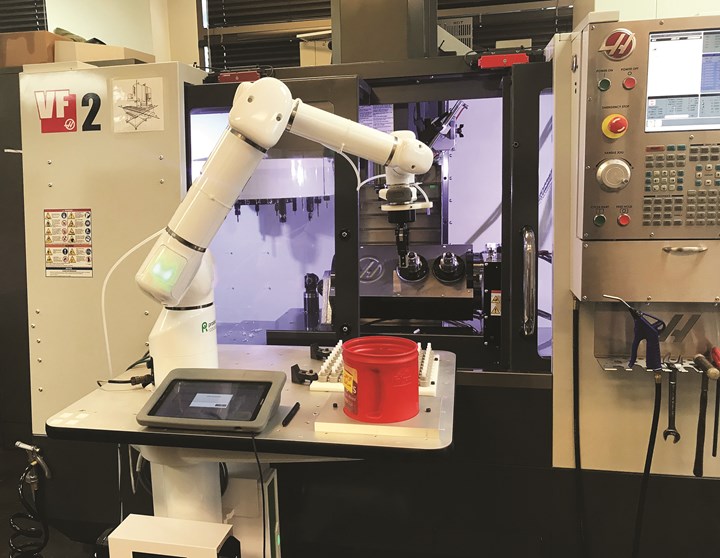OB7’s Seventh Axis and a Digital Printer
The creator of the OB7 robot, Zac Bogart, talks about how this human-like robot arm came to be.
With a focus on designing its robots for the best fit for the most jobs, Productive Robotics created the OB7 with a seventh axis or seventh joint. This seventh axis is the characteristic that enables the robot to reach around obstructions, as a human arm can. Without the seventh axis, this motion is impossible, according to Zac Bogart, president of Productive Robotics.
“The seventh axis is the motion you use if you are arm wrestling — using the motion of your upper arm,” Bogart explains. “That’s the movement that gives machine shops the flexibility to put the robot somewhere other than smack dab in the middle of the work area, so it’s much more user friendly.”
Although Productive Robotics’ OB7 is relatively new to the market, the technology has been evolving since the 1980s when Bogart developed robots in the motion picture special effects business. This job enabled him to design robotically controlled camera systems that camera operators could program on their own. This meant, to him, that he needed to create a system that required no programming, which he did.
“Back in those days, you would fly it around with joysticks like a model airplane,” he explains. “Then, the computer would learn all of these movements and then be able to recreate the movements on film.”
About eight years ago, Bogart started a new company that focused solely on robots; thus, Productive Robotics was born, and then along came what is now called the OB7 in 2017. This time, though, Bogart recognized that computers have become more sophisticated, allowing for less challenging and more rewarding robot creation.
Bogart’s understanding of robot technology comes from the similar technology he learned at the other company he owns that makes high-end digital printing systems. According to him, although they do not appear similar, digital printers are designed to control many elements with a computer, as do robots.
“The technology has evolved all the way through, and that’s the common thread,” he explains.
Read how two OB7s enabled two second-op mills to run lights out at Swiss Productions Inc. in the article, “Human-Like Robot Automates Secondary Machining Operations.”

RELATED CONTENT
-
The Many Sides of Workholding
Here's a broad look at different ways to approach workholding, from bar feeders to collet chucks to robotics.
-
The Effects of Automation on Manufacturing
Companies that are not currently using automation in their manufacturing processes should be considering it.
-
Smart Workholding Device Measures and Monitors
Sensor and IIoT technology combine to enable these chucks and mandrels to automatically monitor workholding parameters and measure part features to ensure process stability.



